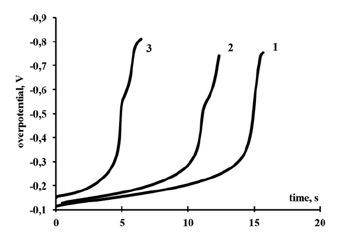Measurement of the specific surface area of loose copper deposit by electrochemical methods
E. A. Dolmatova, A. V. Patrushev, T. N. Ostanina
Abstract
In the work the surface area of the electrode with dispersed copper deposit obtained within 30 seconds was evaluated by techniques of chronopotentiometry (CPM) and impedance spectroscopy. In method CPM the electrode surface available for measurement depends on the value of the polarizing current. At high currents during the transition time there is a change of surface relief that can not determine the full surface of loose deposit. The electrochemical impedance method is devoid of this shortcoming since the measurements are carried out in indifferent electrolyte in the absence of current. The area measured by the impedance is tens of times higher than the value obtained by chronopotentiometry. It is found that from a solution containing sulfuric acid the deposits form with a high specific surface area. Based on these data it was concluded that the method of impedance spectroscopy can be used to measure in situ the surface area of the dispersed copper deposits.
Keywords
current; chronopotentiometry; loose copper deposit; depletion factor; impedance spectroscopy
References
Pomosov AV, Krymakova EE. [Predicting the Properties of Electrolytic Copper Powder]. Poroshk Metall. 1976;6:1–4. Russian.
Ostanina TN, Rudoy VM, Nikitin VS, Darintseva AB, Zalesova OL, Porotnikova NM. Determination of the surface of dendritic electrolytic zinc powders and evaluation of its fractal dimension. Russian Journal of Non-Ferrous Metals. 2016;57(1):47-51. doi:10.3103/S1067821216010120
Vetter KJ. Electrochemical Kinetics, Theoretical and Experimental Aspects. New York: Academic Press; 1967. 789 p.
Jurczakowski R, Hitz C, Lasia A. Impedance of porous Au based electrodes. J Electroanal Chem. 2004;572(2):355–66. doi:10.1016/j.jelechem.2004.01.008
DOI:
https://doi.org/10.15826/chimtech.2016.3.2.011
Copyright (c) 2016 E. A. Dolmatova, A. V. Patrushev, T. N. Ostanina

This work is licensed under a
Creative Commons Attribution 4.0 International License.
Chimica Techno Acta, 2014–2025
eISSN 2411-1414
Copyright Notice








